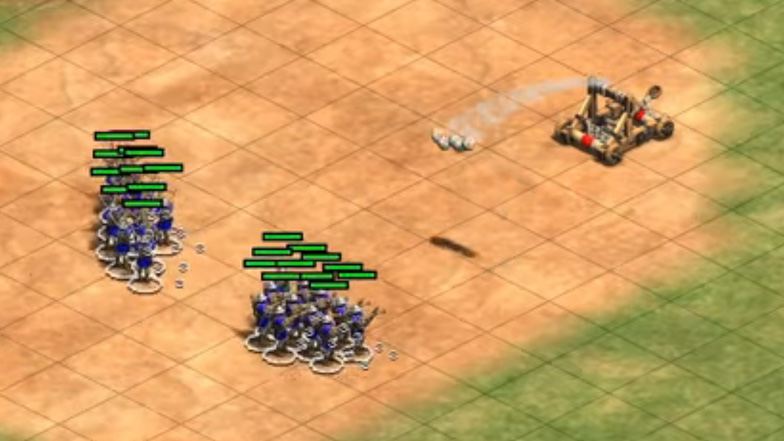
Villagers can create farms, harvest from wild berry bushes, or hunt packs of boar and/or deer. It is used up the most and also easiest to harvest. Food is primarily used to create villagers and soldiers. Finally, there's food, the most important resource to any civilization. It can be mined from the few stone deposits found on the map. It's used for building castles and stone walls. Stone is the least important, but still useful, resource. It is harvested from mines established on deposits of gold. Otherwise, it can be used to pay for researching certain technologies, or constructing certain buildings. Usually this is used when creating military units. They can drop off the wood at a lumber camp, or your town centre. It is gathered by having your villagers cut down trees. Wood is used for most buildings and some soldiers, such as archers. There are four resources necessary to wage a successful war: Wood, Gold, Stone and Food. The gameplay in Age of Empires II: The Conquerors remains largely unchanged from Age of Empires II: The Age of Kings Changes: Many smaller upgrades including: new multiplayer maps, the ability to have farms automatically replant, more efficient game recording, new technologies, and garrisoning in battering rams. New Technologies: There are twenty-six additional technologies.New Units: Eagle warriors, Jaguar warriors, Conquistadors, Halberdiers, Missionaries, War Wagons, Turtle ships, Tarkans, Hussars, Petards and Plumed Archers.AI Upgrades: Villagers and siege weapons are smarter.Tile Sets: New Jungle & Winter tile sets.Game Types: King of the Hill (Wonder), Wonder Race and Defend the Wonder.Campaigns: Montezuma, Attilla the Hun, El Cid and several miscellaneous one-map campaigns (Agincourt or Hastings, for example).Civilizations: Aztecs, Mayans, Spanish, Huns, and Koreans.But "The Fall of Aquileia, Milan, Padua, and Verona" just doesn't have the same ring to it. Rome, of course, will not be falling in this final scenario. While the empire itself staggered along for another 25 years, its military was utterly and permanently obliterated. The walkthrough to the sixth El Cid scenario! Attila the Hun 5: “The Catalaunian Fields”Īlso known as the Battle of Chalons, this was the Roman Empire's last hurrah. The walkthrough to the fifth El Cid scenario! El Cid 6: “Reconquista” When Attila declared war on Aetius in 450, only half the Burgundians remained in Roman employ, while the other half apparently saw the Huns as the lesser of two evils. For example, Aetius actually hired Attila to defeat the Burgundians in the 430s - a war which, over a thousand years later, comes down to us as the Nibelungenlied - then Aetius hired the Burgundians to settle the Rhone valley during the 440s. Attila the Hun 4: “A Barbarian Betrothal”įun Fact! The relationships between Attila, Aetius, and the Burgundian king Gunther, were a bit more complicated than presented here. Don't be afraid to re-task your Villagers, and keep your eyes on the 10,000-gold prize. This scenario is more about resource management than anything else, especially since you can't build Markets. Attila the Hun 3: “The Walls of Constantinople”

Fortunately, only two of your enemies will put up any resistance, and neither of them is very aggressive. Your population in this scenario is a mere 75 units.

With that said, let's saddle up for the Fifth Century! Attila the Hun 2: “The Great Ride” In this scenario, the limit is 125 units: 50 units higher than in the original Age of Kings game! (Or for that matter, the first scenario in the Montezuma campaign, featured in the demo.) Also, since you play as the Huns, your "available housing" is automatically set to this limit, without the need to waste time and timber on Houses. This is the first campaign in the Conquerors expansion, and as such it's important to note that your population limit varies throughout the campaign. Tag: The Conquerors Campaigns Attila the Hun 1: “The Scourge of God”


 0 kommentar(er)
0 kommentar(er)
